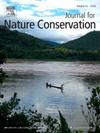Nature conservation in the Draa Basin (Morocco): History, present situation, and future challenges
IF 2.5
3区 环境科学与生态学
Q2 BIODIVERSITY CONSERVATION
引用次数: 0
Abstract
Land degradation, the depletion of natural resources and climate change threaten arid social-ecological systems. To recommend needed actions and review the changes that affect the natural environment of the Draa Basin, an arid river basin in southern Morocco, we provide an overview of past, current and possible future developments. From an ancient human society living in balance with nature, over the first degradation processes caused by grazing and a greater demand for resources, to the major changes caused by river dams, and the intensification of agriculture and human population growth, the basin has undergone numerous anthropogenic changes. Together with illegal wildlife trade and overhunting, this has led to declining population sizes and the extinction of species such as the Barbary lion. Increasing efforts of governments, accompanied by multilateral environmental agreements, set nature conservation processes in motion in the 20th century. This started the creation of initiatives and protected areas, such as Iriqui National Park. The future pressures of climate change and water scarcity require increased efforts and effective conservation to preserve the natural and socio-cultural heritage of the Draa Basin for a resilient and sustainable future. Based on this extensive literature review, we therefore provide recommendations that can pave the way to a sustainable future for this and other arid and non-arid regions worldwide. The following points are identified as key leverage points: conservation and restoration of habitats, sustainable resource use, prevention of desertification and land degradation, and the involvement of all demographic groups and stakeholders in conservation planning.

德拉盆地(摩洛哥)的自然保护:历史、现状和未来挑战
土地退化、自然资源枯竭和气候变化威胁着干旱的社会生态系统。为了建议需要采取的行动,并审查影响德拉盆地自然环境的变化,我们概述了过去、现在和可能的未来发展。德拉盆地是摩洛哥南部的一个干旱河流流域。从人类与自然和谐共处的古代社会,从第一次因放牧和对资源的更大需求而导致的退化过程,到河流大坝、农业集约化和人口增长造成的重大变化,流域经历了无数人为变化。再加上非法野生动物贸易和过度捕猎,这导致了种群数量的下降和巴巴里狮等物种的灭绝。20世纪,各国政府不断加大努力,加上多边环境协定,推动了自然保护进程。这开启了倡议和保护区的创建,如伊里基国家公园。未来气候变化和水资源短缺的压力要求加大努力和有效保护,以保护德拉盆地的自然和社会文化遗产,以实现有复原力和可持续的未来。因此,基于这一广泛的文献综述,我们提出建议,为该地区以及全球其他干旱和非干旱地区的可持续未来铺平道路。确定下列要点为关键杠杆点:生境的保护和恢复、资源的可持续利用、防止荒漠化和土地退化,以及所有人口群体和利益攸关方参与保护规划。
本文章由计算机程序翻译,如有差异,请以英文原文为准。
求助全文
约1分钟内获得全文
求助全文
来源期刊

Journal for Nature Conservation
环境科学-生态学
CiteScore
3.70
自引率
5.00%
发文量
151
审稿时长
7.9 weeks
期刊介绍:
The Journal for Nature Conservation addresses concepts, methods and techniques for nature conservation. This international and interdisciplinary journal encourages collaboration between scientists and practitioners, including the integration of biodiversity issues with social and economic concepts. Therefore, conceptual, technical and methodological papers, as well as reviews, research papers, and short communications are welcomed from a wide range of disciplines, including theoretical ecology, landscape ecology, restoration ecology, ecological modelling, and others, provided that there is a clear connection and immediate relevance to nature conservation.
Manuscripts without any immediate conservation context, such as inventories, distribution modelling, genetic studies, animal behaviour, plant physiology, will not be considered for this journal; though such data may be useful for conservationists and managers in the future, this is outside of the current scope of the journal.
 求助内容:
求助内容: 应助结果提醒方式:
应助结果提醒方式:


